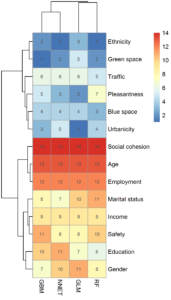News
How important are perceived physical and social neighborhood characteristics on depression?
The physical and social neighborhood environments are increasingly recognized as determinants for depression. There is little evidence on combined effects of multiple neighborhood characteristics and their importance.
Our aim was (1) to examine associations between depression severity and multiple perceived neighborhood environments; and (2) to assess their relative importance. Cross-sectional data were drawn from a population-representative sample (N = 9435) from the Netherlands. Depression severity was screened with the Patient Health Questionnaire (PHQ-9) and neighborhood perceptions were surveyed. Supervised machine learning models were employed to assess depression severity-perceived neighborhood environment associations.
We found indications that neighborhood social cohesion, pleasantness, and safety inversely correlate with PHQ-9 scores, while increasing perceived distance to green space and traffic were correlated positively. Perceived distance to blue space and urbanicity seemed uncorrelated. Young adults, low-income earners, low-educated, unemployed, and divorced persons were more likely to have higher PHQ-9 scores. Neighborhood characteristics appeared to be less important than personal attributes (e.g., age, marital and employment status). Results were robust across different ML models.

Figure: Clustered heat map of the variable importance across different machine learning models. The number per cell refers to the variable rank. Higher ranks indicate more important variables.
This study suggested that the perceived social environment plays, independent of socio-demographics, a role in depression severity. Contrasted with person-level and social neighborhood characteristics, the prominence of the physical neighborhood environment should not be overstated.
The full paper is freely available.

